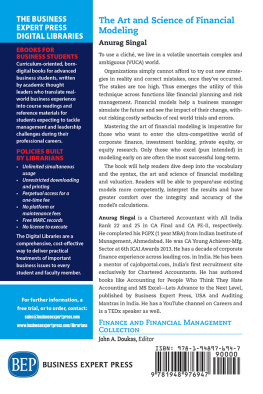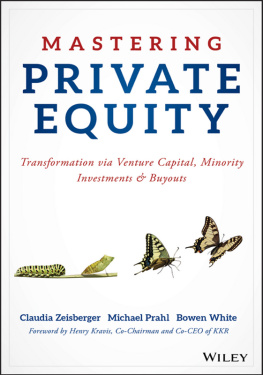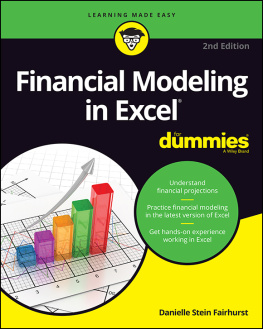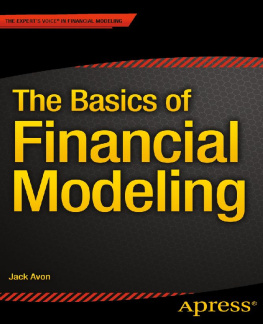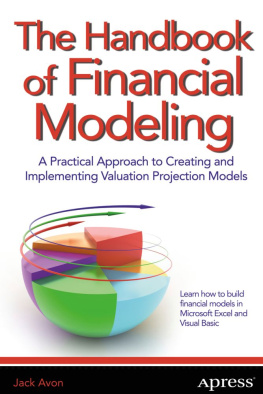All rights reserved. This book or any portion thereof may not be reproduced or used in any manner without the express written permission of the author except for the use of brief quotations in book reviews.
Preface
Who is this book for?
Modeling Leveraged Buyouts - Simplified is for MBA, CFA or undergraduate finance students interested in understanding and modeling leveraged buyouts (LBO). This book is also helpful for financial executives and others interested in understanding and modeling LBOs. It is a wonderful resource for students or professionals interviewing for jobs in the private equity, investment banking or hedge fund industry because it will teach you how to build a basic LBO model in 1-2 hours.
This book assumes that the reader is familiar with basic finance and accounting concepts. For example, the reader is expected to know the structure of an income statement, the meaning of the term working capital, internal rate of return (IRR) and multiples. The reader is NOT expected to be an expert in Microsoft Excel but has to be reasonably familiar with Microsoft Excel.
No two LBO transactions are exactly alike. Each LBO transaction will have unique features, characteristics and structure. This book will teach you how to build a simple LBO model. Once you can confidently build a simple LBO model, you can add many bells and whistles to reflect the numerous specifics of the LBO transaction you are considering or modeling.
Modeling Leveraged Buyouts - Simplified is based on Senith Mathews experience tutoring students and executives in financial modeling over 10 years and building models as a management consultant with Arthur Andersen and Mercer Management Consulting (now Oliver Wyman). Modeling Leveraged Buyouts - Simplified narrowly focusses on modeling leveraged buy outs given the surge in interest in LBOs.
The first part of Modeling Leveraged Buyouts - Simplified (chapters 1-5) walks you through building and analyzing an LBO model step by step. The first chapter of the book lays the foundations of the LBO model outlining the basic principles, components and structure of an LBO model. The second chapter lists and describes the ingredients of an LBO model. This chapter covers the background and assumptions required to build an LBO model. The third chapter of the book shows you how to build the heart of an LBO model: the cash flow projections. It is the cash flow projections that drive investment returns and performance. The fourth chapter of the book teaches you how to develop the output of an LBO model. Here we look at how to compute the key metrics in an LBO transaction. You will see how a projects returns differs from the private equity investors returns and how a project may give poor returns but the private equity investor generates huge returns from the same LBO transaction. The fifth chapter of this book teaches you how to analyze the LBO model you have just built. We show you why and how sensitivity analysis is done. We also study how an LBO will create value and teach you how to quantify the value generated by the different drivers of value creation in chapter 5.
The second part of Modeling Leveraged Buyouts - Simplified addresses a few additional topics. Chapter six outlines formatting guidelines to make your model look professional. Chapter seven lists out the Microsoft Excel functions used in the LBO model. We believe that if you can confidently build this model, you can add the numerous features you will encounter in an LBO transaction. Chapter eight gives you a list of additional features that can be built on top of this LBO model if a transaction that you are modeling features them.
We do not stop there! If you have learnt to model an LBO transaction, we are sure you will be on the lookout for companies you can do a leveraged buyout on. You could buy a firm yourself or have a list of potential LBO targets to impress a potential interviewer with. We teach you how to identify potential LBO targets in the epilogue.
The companion website provides readers with case studies for practice and other LBO resources.
How to use this book
Modeling Leveraged Buyouts - Simplified is built on our modeling boot camps experience and so it is best you adopt a hands-on boot camp attitude as you read this book to maximize your learning from this book. You should be confident of building a LBO model on your own in 1-2 hours after working through this book. You should read this book at least twice to master modeling leveraged buyouts.
Your first read is meant to give you a quick overview of the entire process. You should follow the model spreadsheet as you progress through the book. Read each section one by one. Once you have read a section, review the corresponding region in the Microsoft Excel model. Change the relevant input assumptions to see how that section changes. Dig into each cell of the Microsoft Excel model row by row so you understand the formula and relationships section by section.
Your second read is when you should open up a blank workbook and build the exact LBO model yourself. We recommend that you re-read the book from the beginning or from Chapter 2. As you re-read each section re-create that section in a blank workbook. Begin by setting up the same input assumptions and build the LBO model section by section. Check each section of your model and proceed to the next section only after you are sure it reflects the sample model. Your final model should reflect the sample LBO model when you are done. Change the relevant input assumptions in your LBO model to check that the model returns reflect the changes in the books model.
This should give you the confidence to model an LBO transaction on your own. Now you are ready to tackle the case studies provided. We recommend you work on the case studies with a friend or a tutor so that you get instant feedback. Good timely feedback boosts your learning process tremendously.
Chapter 1: Foundations of an LBO Model
Give me six hours to chop down a tree and I will spend the first four sharpening the axe.
~Abraham Lincon
The primary purpose of this book is to teach you how to model an LBO transaction. We jump right into building a simple LBO model without wasting time. However, we must start with the foundations. Having the right foundation and approach will help you build a model quickly and efficiently. This will save you a significant amount of time and rework. Here are some guiding principles before we jump into the numbers.
1.1 First Principles
1.1.1 Analysis of Reality vs. Fantasy
The objective of financial modeling is to simulate key operational and financial numbers of a transaction so they can be studied and undertaken only if profitable. Therefore, a model should reflect reality as much as possible. The same holds true for an LBO model. A good LBO model is one in which the inputs, computations, outputs and the relationships between them should reflect what they would be in that specific transaction in the real world. This means that you should know or have studied the industry, firm, rules, potential strategies, etc. thoroughly to model the LBO transaction well. Each industry and transaction will be different. What is appropriate for this firm, industry or a time period may not be appropriate for another firm, industry or a time period.
1.1.2 Simple vs. Complex
If given a choice, choose the simple option over the complex one, unless the latter adds significant value. When modeling, follow the advice of the wise man Albert Einstein:




